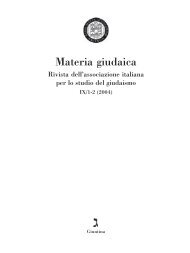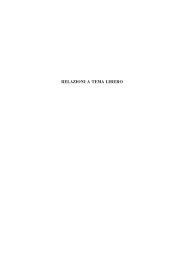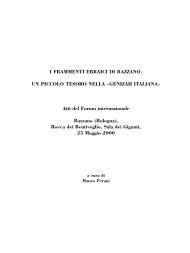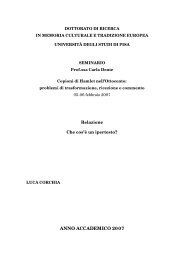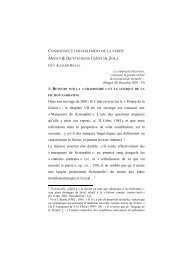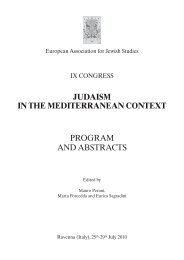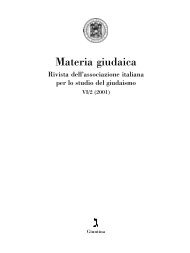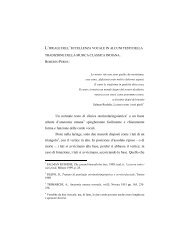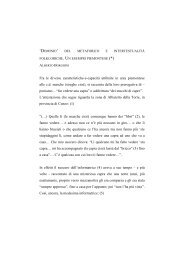161 Abraham Gross GERONA: A SEPHARDIC CRADLE OF ...
161 Abraham Gross GERONA: A SEPHARDIC CRADLE OF ...
161 Abraham Gross GERONA: A SEPHARDIC CRADLE OF ...
You also want an ePaper? Increase the reach of your titles
YUMPU automatically turns print PDFs into web optimized ePapers that Google loves.
A Sephardic Cradle of Jewish Learning and Religiosity<br />
thinking – be it in studying Talmud or in his religious-pietistic<br />
Weltanschauung – is conspicuously<br />
influenced by it, even if the extent of the distinct<br />
marks of Haside Ashkenaz in his writings are still<br />
a subject for debate. His pious stand in the controversy<br />
over the philosophical writings of<br />
Maimonides, his tendency to mysticism, his ethical<br />
literary works, and his courageous struggle<br />
against corrupted Jewish leadership in Barcelona<br />
all point to his Ashkenazic education.<br />
He return to Spain and – possibly after<br />
spending some time in Gerona 11 – he became a<br />
distinguished religious authority in Barcelona and<br />
then in Toledo. As such he served as an important<br />
ring in the historical chain – culminating in<br />
the «easy absorption» 12 of Asher ben Yehi’el as<br />
the rabbi of Toledo – that linked Spanish Jewry<br />
with Ashkenaz. This changed in many ways the<br />
religious complexion of Spanish Jewry, be it in<br />
the curriculum of the study of Bible and Talmud<br />
or in religious tendencies expressed eventually in<br />
the readiness of some in 1391, and many in the<br />
end of the 15 th century, to perform active martyrdom<br />
in the manner which characterized<br />
Ashkenazic Jewry.<br />
One of the undisputedly giants of the Medieval<br />
Jewish intellectual history is a Geronese<br />
named Moses ben Nahman (Nahmanides). The<br />
unparalleled breadth, depth, and originality<br />
which characterizes his literary contributions<br />
run almost the entire gamut of religious genres<br />
and includes; peshat and mystical biblical<br />
exegesis, talmudic super-commentaries,<br />
Halakhah (including responsa), anti-Christian<br />
polemics, liturgical and non-liturgical<br />
poetry, sermons, ethical treatises, and<br />
Qabbalah 13 .<br />
Unlike Jonah Gerondi, Nahmanides’ life,<br />
almost in its entirety, is bound with Gerona. His<br />
two main teachers were Judah ben Yaqar, who<br />
carried with him French traditions of learning<br />
and spirituality, and Nathan ben Me’ir, who<br />
brought with him Provencal methods, tendencies,<br />
and traditions, including mystical ones.<br />
It would be problematic, to say the least,<br />
to attempt to summarize here such a versatile,<br />
complex, and multi-faceted personality. However,<br />
at the risk of sounding over-simplistic, I would<br />
say that his stand on major issues of his time,<br />
such as the controversy over the philosophical<br />
writings of Maimonides, combined with his criticism<br />
of philosophy on subjects such as Divine<br />
Providence etc. reveal a conservativeparticularistic<br />
religious attitude - never a militant<br />
one - with a touch of ascetic piety.<br />
Nahmanides, together with the qabbalistic<br />
circle of Ezra, Azriel, Jacob ben Sheshet Gerondi<br />
– an influencial author in his own right – and others<br />
fortified Gerona as a firm anti-rationalist<br />
center in the 13 th century.<br />
This general conservative attitude, but without<br />
the mystical element, which was rejected by him,<br />
can describe Nissim Gerondi – the most important<br />
Geronese talmudic scholar of the 14 th century – as<br />
well. His method of study – as can be seen in his<br />
major talmudic work, the commentary on Alfasi’s<br />
Halakot – rests firmly on that of Nahmanides’ and<br />
11 G. SCHOLEM, Te‘udah hadawah le-Toledot<br />
Re’wit ha-Qabbalah, in Y. FICHMAN (ed.), Sefer<br />
Bialik, Part II, Tel Aviv, 1934, p. 144. Chavel,<br />
Ramban [above, n. 5], p. 58 n. 63.<br />
12 I am using here Ta-Shma’s coined expression:<br />
I. TA-SHMA, Hasidut Awkenaz bi-Sefarad:<br />
Rabenu Yonah Gerondi ha-Iw u-Fo‘alo, in<br />
A. MIRSKY, A. GROSSMAN, Y. KAPLAN (edd.), Galut<br />
Ahar Golah: Studies in the History of the Jewish<br />
People Presented to Professor Haim Beinart on the<br />
Occasion of His Seventieth Birthday, Jerusalem<br />
1988, p. 171.<br />
13 By the way, Gerona in this period represents<br />
also a shift in secular poetry from conventions we<br />
are accustomed to in the classical period of poetry<br />
in Moslem Spain, through a “school” associated<br />
with Nahmanides and Meshullam Dapiera. A<br />
short insightful, though general, article by Ezra<br />
Fleischer analyzes this attempt, and terms it as<br />
«genuine, powerful, imaginative and daring».<br />
Elements of it lived on in 14 th -15 th centuries poetry,<br />
especially in the Aragonese circle of Solomon<br />
Dapiera, Vidal Benvenist, Solomon Bonafed and<br />
others: see E. FLEISCHER, The ‘Gerona School’ of<br />
Hebrew Poetry, in I. TWERSKY (ed.), Rabbi Moses<br />
Nah manides (Ramban): Explorations in His<br />
Religious and Literary Virtuosity Cambridge,<br />
Mass, 1983, pp. 35-50. See also, on Nahmanides,<br />
M. IDEL e M. PERANI, Nah manide esegeta e<br />
cabbalista. Studi e testi, La Giuntina, Firenze<br />
1998.<br />
163



